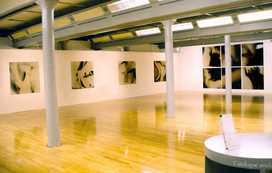
Elective Affinities Installation Tate Liverpool 1993
Elective Affinities is about art that finds an immediate physical response in you, the viewer. It focuses on the relationship between art and the spectator standing in front of it. Whether or not you like the work, it produces a sense of recognition which depends on the body.
Elective Affinities was the title used by the German writer Goethe for his novel about the physical magnetism between two people. It was the name of a contemporary chemical theory describing the attraction of like for like, and Goethe deliberately used it to set up a parallel between human behaviour and scientific laws.
All the artists in this show have used the body as their subject. Some of them have used their own bodies, others not. None have portrayed the whole body, but some have fragmented it much more thoroughly than others. Some have used particular parts for their symbolic meaning, whereas others have abstracted from the body, projecting a sense of life.
There are seven groups of work in this exhibition by:
- Hannah Villiger, born 1951 in Switzerland and now based in Paris
- Thomas Florschuetz, born 1957, in East Germany and now based in Berlin
- Jayne Parker, born 1957, in England and now based in London
- Pauline Cummins, born 1949 and Louise Walsh, born 1963, in Ireland and now based in and around Dublin
- Hermione Wiltshire, born 1963 in England and now based in London
- Helen Chadwick, born 1953 in England and now based in London
- Jana Sterbak, born 1955 in Czechoslovakia and now based in Montreal.
Thomas Florschuetz uses the camera to photograph small parts of his own body which he then enlarges to make prints measuring c. 1800 x 1200 mm. The actual photography sessions only happen a couple of times a year. Florschuetz spends most of his time working with the small frames from contact sheets; collecting a large stockpile of photographs from which he chooses those to develop into large scale work.
Hannah Villiger also photographs her own body and uses a Polaroid camera held in her hand. We are aware of the limits of the body's reach. There is thus a sense of a cube, or a box, around Villiger's figure, which is reinforced by the dense, square format of the Polaroid print.
Much of Jayne Parker's work is about experience as registered through the body. She is not particularly fond of using herself in her own films, but she has acted in these ones, partly because she had to do things which she found distasteful and did not wish to impose on anybody else. Her work deals with the relationship between inside and outside; how our mental state manifests itself through physical gestures, and how external behaviour is often used to symbolise inner feelings.
At the other end of the gallery is an installation called Sounding the Depths by Pauline Cummins & Louise Walsh. The closed shell is the starting-point, and on the right is a video projection which shows images of the closed and tense body, the closed shell echoing the closed lips and hands. The spaces of the installation are significant: you move from this cold outer forum, into a dark, enclosed room on the right.
In this inner enclave the body is opened up. The five large colour photographs around you show images of the artists' bodies with their mouths superimposed on their torsos. The soundtrack of running laughter seems reassuring after what might at first seem shocking. Instead we realise that these bodies seem to be at one with themselves – happy, even triumphant. The mouth over the body suggests that now the object has a voice.
Hermione Wiltshire was Artist-in-Residence last year at Tate Liverpool. Much of her work here was about finding an abstract way to make sculpture about the body, and to give it a sense of being alive. She used materials like plaster or glass which, in their liquid state, escape the artist's control and have a life of their own.
The photographs of Wiltshire's fingerprints in My Touch give us proof of the artist's presence. The way that the glass is pulled out from the wall suggests that these marks are still sticky, and that we too might get stuck. Although we are drawn in, we also know that glass is dangerous, and that we ought to keep our distance.
Next door is the installation by Helen Chadwick of her twelve Piss Flowers. Chadwick made these sculptures when she was invited out to Northern Canada during the winter. She knew that the Art Centre in Banff would be surrounded by deep snow, and being interested in the way that her body can interact with the world outside, she wanted to find a strategy with which to approach this environment.
Jana Sterbak draws on Jewish folklore in Golem:Objects as Sensations. A 'Golem' is an artificial man fabricated in clay by the alchemists and brought to life with fire, water and air. In the process of making Golem Sterbak became increasingly interested in the meanings of specific materials. Photography particularly allowed her to let her imagination go and make three proposals in which materials radically affect the meaning of what they represent.
